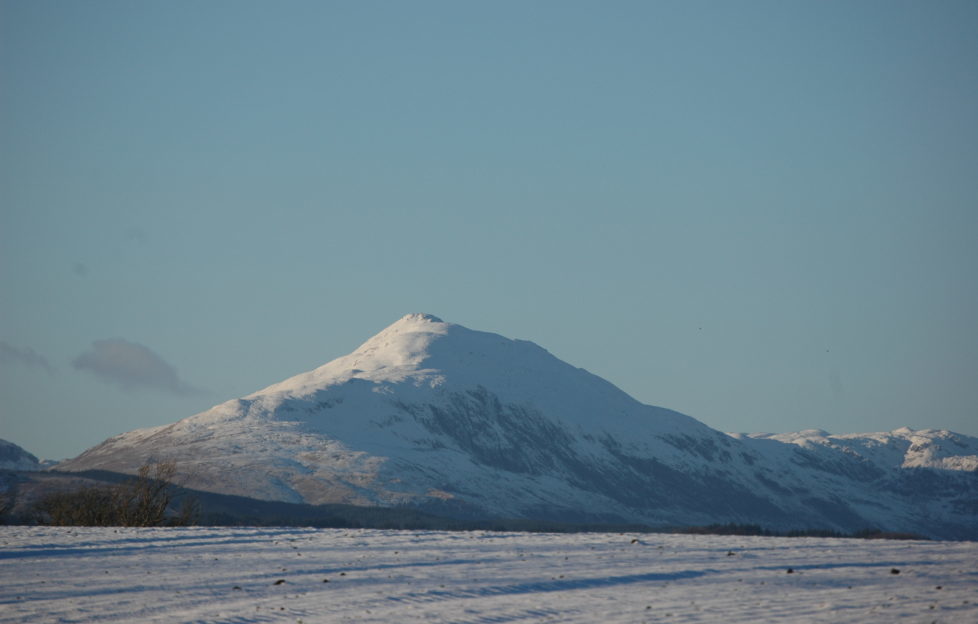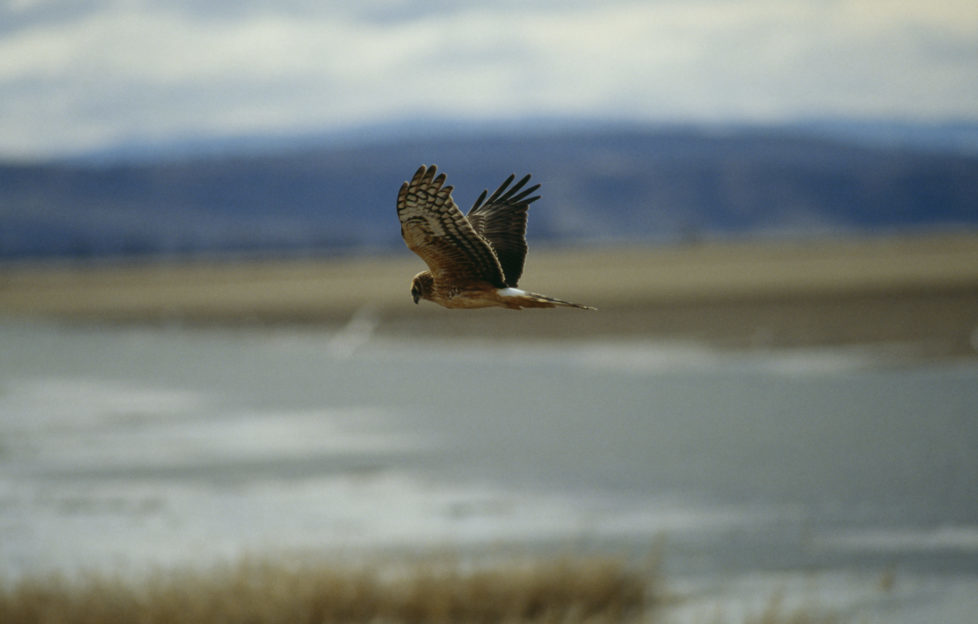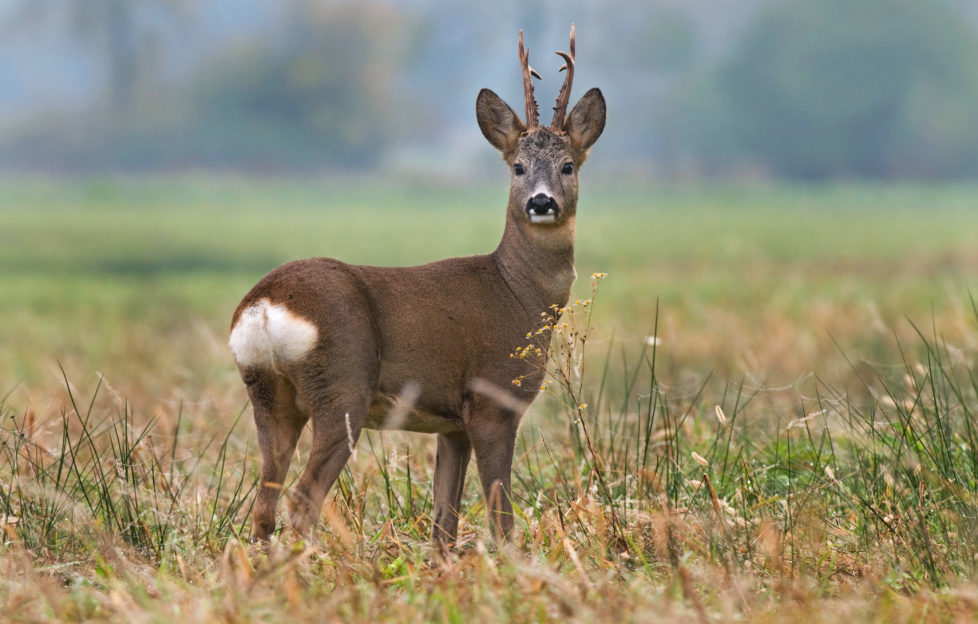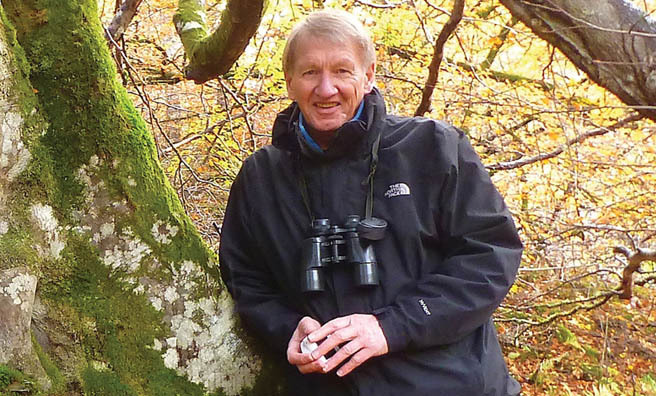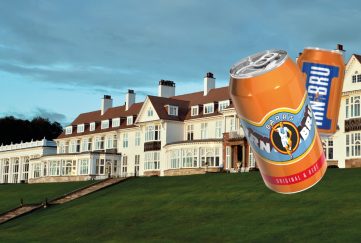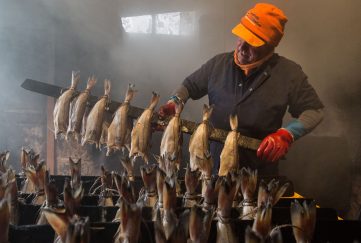Jim Crumley | A Day In The Life…
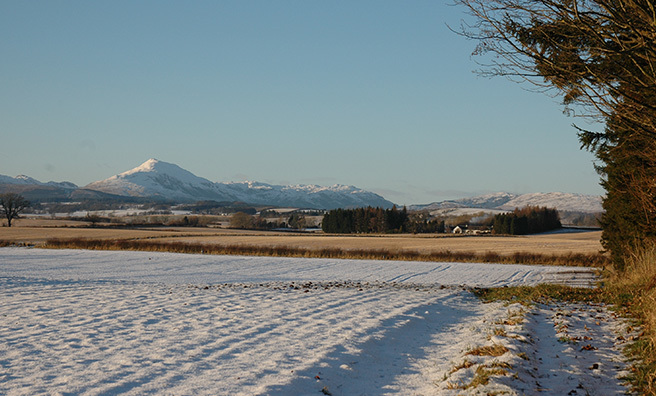
An insight into a typical day for nature writer Jim Crumley …
I am walking the line between Highland and Lowland, a ridge to the south of the Trossachs’ mountain heart. I am treading a fine line between winter and spring and there are tastes of both on the air.
The mountains cling to their snowy preferences, and from time to time the wind drags a flimsy veil across the high ridges and shrugged shoulders of Ben Ledi, Ben Venue and Ben Lomond.
The Lowland view is over my right shoulder and extends all the way to Stirling Castle, a grey smudge on its rock beyond the glittering, unfurling Forth and the sunlit fields of the Carse.
“this no-man’s-landscape athwart the high and the low”
So often, these last twenty-five years, these have been my landscape familiars, the core of my writing territory, the stabilising lands of my working life and the base from which to travel – east to the deeper love of the Tay estuary that nurtured me and has never really freed me, north and west to the mountain and island lands that fire my imagination and beckon forever, south more rarely to friends in Galloway and family in the north of England; and one day perhaps I’ll call my own bluff and see bits of Spain and Sicily that fire my imagination differently. Perhaps.
But more often than not this is my native inclination, right here, this no-man’s-landscape athwart the high and the low, one foot in each of the two lands of Scotland.
There is snow underfoot, but it is old snow and patchy. There is warmth in the sun, but it is a cautious warmth, tempered from time to time by that snow-bearing wind that dives down from the ridges on madcap errands without real purpose or intent.
I have been wondering as I walk what it is about this is of all places that gathers me in from all my wandering wherevers. Why is it where I always end up when I have no destination in mind? Trees, I have just decided, are at least part of the answer. There are no more extensively wooded acres than these anywhere in Scotland, and there is a profound and optimistic spirit of reconciliation in the air to reunite the land with its ancient preference for woodland, to permit something like the tree cover of its past to inform its future. The trees are on the march here, as enthusiastically as I am myself. Nature and I are in accord about this: we both approve of native trees in a native landscape.
Also, I like edges – the edge of the ocean, the edge of the Highlands, the edge of a wood, the edge of a clearing…
Nature Watch
I have been watching a wide clearing among the trees for an hour now, an open tract of the broad-backed ridge, a place of winter-bleached grass, sparse and tussocky heather, pockets of ice-hardened peat bog and occasional remnants of hoary old pine trees quietly regressing back into the land that bore them.
I stopped to watch in the first place because of the hen harrier, a ring-tail, a female in other words, not as glamorous as her silver-grey mate (if indeed she has one yet for no male has shown itself, though ‘tis the season…), but supremely tailored for a moor-dwelling hunter in all the moor’s shades, enlivened by that calling-card flash of bright white above the dark brown and pale grey bands that both adorn the tail and make a less regular but more fabulous flourish of her underwings.
The rest of her is greyish-brown darkening to brownish-grey except for the owl mask she wears, a mask that somehow looks too small for her head, until you see the yellow and unforgettable eyes and then you forget the mask. I have found a rock to sit on and watch.
The truth is that I had stopped to watch a roebuck. I had not seen the harrier until she flew through that portion of the landscape where the binoculars lingered with the roe deer at its centre. I saw the deer’s head turn to follow the bird’s flight as she passed a dozen yards away at shoulder height. I saw the bird’s head turn a passing glance towards the roebuck. Do they know each other? So there was a moment, less than a second, where the harrier with her wings low and her tail tightly furled was framed against the flank of the buck when their eyes met, and if I had been a wildlife painter or photographer of uncommon distinction I might have immortalised the moment with something more stirring than a paragraph. But I am neither of these things. I am a maker of paragraphs. Sometimes, just by being out and quiet and still and with my eyes wide open and with a thirst for nature’s bold gestures, I find myself in the right place at the right time, and nature drops something rare in my lap, and my response is to write it down. I call this process “working”. There are worse jobs.
The harrier is a hundred yards away now where a north-making gap in the trees leads to bare hillside, an open shelf of old snow that faces the mountains. I see her lean her right wingtip towards the ground, her left towards the sky. She bores into the middle of the gap at an angle of 45 degrees, levels out again and drops to within a yard of the grass. Of all the hunting birds that I have ever seen, only a golden eagle can do this low-level airborne stalk slower than a harrier, that sliver of airspeed above stalling that reaches such a tense pitch of slowness that it seems it must run out of momentum and throw the bird forward and downward in a slaister of feathers, but no, on and on it goes until at last something small and furry loses its nerve in the grass and runs, and dies beneath a great shadow.
A rise in the ground finally claims the harrier’s flight. I turn back to the roebuck, or rather to where the roebuck was standing the last time I saw him, but he stepped away from the clearing while I followed the harrier’s flight. I decide to sit still, or more accurately I do not decide to move. Sometimes a set of nature’s circumstances that proves conducive to – for example – the roe and hen harrier also proves conducive to other tribes of nature and for the same reasons: both harrier and deer had found agreeable conditions in that high clearing to look for food.
I move the glasses slowly through the tops of the nearest trees, a covey of wind-woven Scots pines about a hundred yards away. Then I move them back again. I repeat the process several times over the next half hour or so with chocolate and coffee to help pass the time. On what may have been the fifth or sixth sweep with the glasses I find a red squirrel on a limb perfectly silhouetted against the sky into a caricature of every red squirrel you ever saw, sitting on its haunches, its tail curved up its spine and flicked away from the back of its head, its ears erect, and a pine cone in its “hands”.
This is good, I tell myself. A roebuck, a ringtail, and now a red squirrel. Whatever next? No sooner is the question cast adrift on the air than it answers itself. Crossbills. They cluster into the squirrel’s tree, eight then six more. There are all kinds of theories out there proposed by those who compile the most authoritative guide books with breathtaking detail about how crossbills prefer a certain shape and size of pine tree and red squirrels a different shape and size, and apparently it has to do with the size of the pine cones. On the other hand, if the crossbills are a flock on the move, the presence of a red squirrel in a tree might suggest that here are pine cones enough to refuel for the next leg of the journey.
The stay for five minutes then head off out across the open, sunlit snow, heading north. “Watch out for low flying harriers,” I suggest under my breath.
Part of the landscape
It may be that all this will strike you as a bit like an episode of Springwatch where more happens in half an intensely edited hour than most people will see in half a lifetime. But consider this. By the time I watched the crossbills vanish, I had been sitting still here for over two hours. In that time, the roebuck, the hen harrier, the red squirrel and the crossbills had supplied me with a total of about ten minutes of wildlife activity. Mostly, that’s how it works, and the hard part is the sitting still, is deciding not to move, so that when something does turn up you are a part of the landscape and it treats you accordingly. Nobody and nothing teaches you how to do that. You learn it yourself by trial and error and over years, and you work with what suits you best, and in my case that will mean a handful of landscapes scattered between here and the Tay and a handful of northern and Hebridean islands, but mostly between here, the Carseland to the south and that mountainous arc that is my skyline from west to north.
I walk north in the wake of the harrier and the crossbills. I don’t know where the roe went and the squirrel watches me but declines to move as I pass beneath its tree. Beyond the wood there is a blaze of white light on old snow and the so-familiar shape of Ben Ledi. In the west, the clouds are piling up behind Ben Lomond and it may be that by nightfall there will be a little sting in winter’s tale.
But it’s a small price to pay for such a day in such a landscape.
More…
Click the image below
to read more past
features by our resident nature writer
Don’t forget to pick up the new Scots Mag issue, too, for his latest feature!


